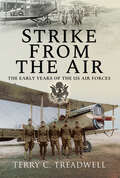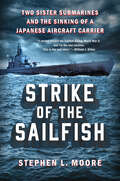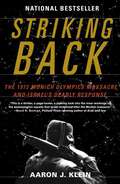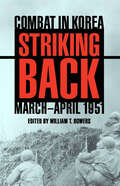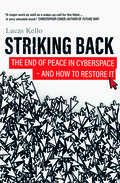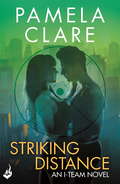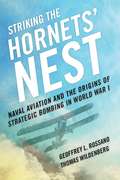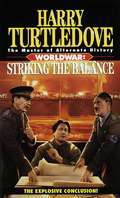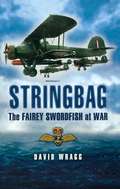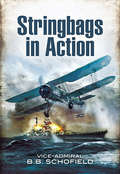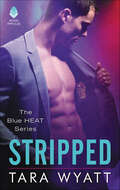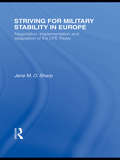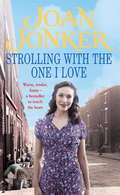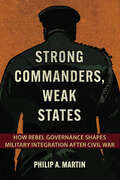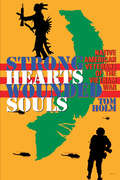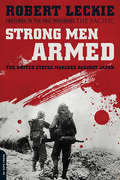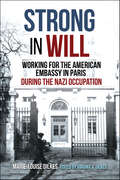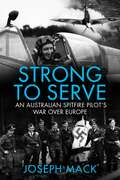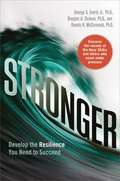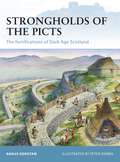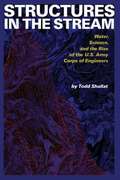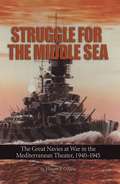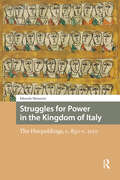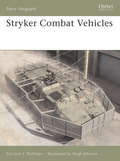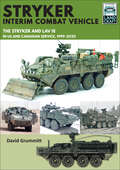- Table View
- List View
Strike from the Air: The Early Years of the US Air Forces
by Terry C. Treadwell“Follows the development of US aviation from the captive balloons of the Civil War, through WWI and into the post war years . . . Highly Recommended.” —FiretrenchStrike from the Air looks at the early development of the U.S. military aviation branches, starting with the Civil War and moving to the first use of military aircraft during General Pershing’s pursuit of the revolutionary Pancho Villa. Before the country was drawn into the First World War, a number of Americans traveled to Europe to volunteer for the Lafayette Escadrille in France, as well as the Royal Flying Corps and the Royal Naval Air Service. Many of these men eventually joined the newly created United States Air Service, taking their valuable experience and knowledge with them. Among the notable early US aviators were individuals such as Eugene Bullard, the first African-American military pilot, and eccentric loners like Frank Luke. The part played by the US Navy and USMC is not neglected.At the end of the First World War, a group of American pilots joined together to form the Kosciuszko Squadron that fought against the Russians in the Polish/Russian War. The final part of the book contains escape reports by USAS pilots and observers, which gives a real insight into the conditions they were subjected to in German prison camps during the First World War. To complete this fascinating look at those exciting and challenging early days, Strike from the Air includes approximately 250 photographs, many of which have ever been seen before.“A remarkable book that shows just how difficult a start American military aviation endured.” —New York Journal of Books
Strike of the Sailfish: Two Sister Submarines and the Sinking of a Japanese Aircraft Carrier
by Stephen L. MooreA gripping true-life thriller about the first US submarine to sink a Japanese aircraft carrier—and the sub&’s tragic twist of fateIn 1939 off the New England coast, the submarine USS Squalus accidentally sinks to the bottom of the sea during a training exercise, killing half her crew. Coming to the rescue is the USS Sculpin, in many ways the Squalus&’s twin. As their oxygen supply dwindles, the remaining crew aboard the Squalus are saved in a time-consuming, white-knuckle operation. Eventually the sunken submarine is raised, repaired, and returned to duty, with a new name: the Sailfish.Four years later, on patrol during the darkest days of the Pacific War, the Sailfish&’s radarman picks up the tell-tale signs of a Japanese convoy, known by U.S. intelligence to include aircraft carriers, the most formidable of all enemy ships. Never before has an American submarine taken down a carrier—much less in the middle of a typhoon. Immediately, the crewmen swing into action, embarking on a deadly game of cat-and-mouse as this once-dead boat evades enemy cruisers to stalk closer and closer to their prized target. Little do they know that aboard the Japanese carrier are survivors of an attack on the USS Sculpin, the very boat that saved the Squalis-turned-Sailfish back in &’39.Author Stephen L. Moore takes readers inside the nine-hour duel, narrating the action aboard both the Sailfish and the doomed carrier, where the American POWs fight against all odds to save their own lives before the ship goes down. Employing a wealth of new information, including long-lost survivors' accounts, fresh interviews with the last of the sub's crew, and official patrol reports, Strike of the Sailfish is the thrilling story of this strange chapter of naval history.
Striking Back
by Aaron J. KleinThe first full account, based on access to key players who have never before spoken, of the Munich Massacre and the Israeli response–a lethal, top secret, thirty-year-long antiterrorism campaign to track down the killers. 1972. The Munich Olympics. Palestinian members of the Black September group murder eleven Israeli athletes. Nine hundred million people watch the crisis unfold on television, witnessing a tragedy that inaugurates the modern age of terror and remains a scar on the collective conscien...
Striking Back: March–April 1951 (Combat in Korea #Bacs)
by William T. BowersThe editor of The Line “gives a human perspective to the war” by focusing on fighting by battalion, company, platoon, squad, and individual soldiers (The Journal of America’s Military Past).Striking Back: Combat in Korea, March–April 1951 is the second book in a three-volume series about the Korean War, examining the fighting that occurred during the late winter and early spring of the war’s first year. By the beginning of March, UN forces shifted strategic focus from defense to offense. In April, the combination of stabilized fronts and the enemy’s failed attacks made conditions ideal for launching combat offensives. The brutal nature and strategic significance of these campaigns is described in the book, which includes analysis of their profound influence on the remainder of the war. William T. Bowers provides detailed battle narratives based on eyewitness accounts recorded by Army historians within days of the operations. Through his use of personal accounts, official records, war diaries, and combat reports, Bowers sheds new light on the conflict in Korea, making this volume a must-read for military historians.“This book is unique.” —In Review
Striking Back: The End of Peace in Cyberspace - And How to Restore It
by Lucas KelloFaced with relentless technological aggression that imperils democracy, how can Western nations fight back? Before the cyber age, foreign interference in democratic politics played out in a comparatively narrow arena. The rapid expansion of cyberspace has radically altered this situation. The hacking activities of Russian military agents in the 2016 US presidential election and other major incidents demonstrate the sophisticated offensive strategies pursued by geopolitical adversaries. The West is winning the technology race – yet losing the larger contest over cybersecurity. Lucas Kello reveals the failures of present policy to prevent cyberattacks and other forms of technological aggression. Drawing upon case studies and interviews with decision-makers, he develops a bold new approach: a concentrated and coordinated response strategy that targets adversaries&’ interests and so recaptures the initiative.Striking Back provides an original solution to national security challenges in our era of intense technological rivalry.
Striking Distance: I-Team 6 (I-Team)
by Pamela ClareFans of Suzanne Brockmann, Maya Banks, Christy Reece, Julie Ann Walker and Cindy Gerard will adore Pamela Clare's expertly plotted romantic suspense series, which sets the pages alight with sizzling chemistry. For tension, thrills, romance and passion take a spin with the I-Team.TV reporter Laura Nilsson spent eighteen months in an Al-Qaeda compound after being kidnapped live on air. Two years later, she's still wondering why. No mission in Javier Corbray's career as a Navy SEAL affected him the way Laura's rescue did. And he wants her more than he's ever wanted anyone. As Laura and Javier's passion ignites, so does Laura's need to discover the mystery of her past. Especially when she learns that her abduction was not random - and that she's still a target for a killer with an impenetrable motive. Now Javier will have to rely on his skills to keep the woman he loves from being struck down before she dares uncover the truth...Sexy. Thrilling. Unputdownable. Take a wildly romantic ride with Pamela Clare's I-Team: Extreme Exposure, Hard Evidence, Unlawful Contact, Naked Edge, Breaking Point, Striking Distance, Seduction Game.
Striking The Hornets' Nest: Naval Aviation And The Origins Of Strategic Bombing In World War I
by Thomas Wildenberg Geoffrey L. RossanoStriking the Hornets’ Nest provides the first extensive analysis of the Northern Bombing Group (NBG), the Navy’s most innovative aviation initiative of World War I and one of the world’s first dedicated strategic bombing programs. Very little has been written about the Navy’s aviation activities in World War I and even less on the NBG. Standard studies of strategic bombing tend to focus on developments in the Royal Air Force or the U. S. Army Air Service. This work concentrates on the origins of strategic bombing in World War I, and the influence this phenomenon had on the Navy’s future use of the airplane. The NBG program faced enormous logistical and personnel challenges. Demands for aircraft, facilities, and personnel were daunting, and shipping shortages added to the seemingly endless delays in implementing the program. Despite the impediments, the Navy (and Marine Corps) triumphed over organizational hurdles and established a series of bases and depots in northern France and southern England in the late summer and early fall of 1918. Ironically, by the time the Navy was ready to commence bombing missions, the German retreat had caused abandonment of the submarine bases the NBG had been created to attack. The men involved in this program were pioneers, overcoming major obstacles only to find they were no longer needed. Though the Navy rapidly abandoned its use of strategic bombing after World War I, their brief experimentation directed the future use of aircraft in other branches of the armed forces. It is no coincidence that Robert Lovett, the young Navy reserve officer who developed much of the NBG program in 1918, spent the entire period of World War II as Assistant Secretary of War for Air where he played a crucial role organizing and equipping the strategic bombing campaign unleashed against Germany and Japan. Rossano and Wildenberg have provided a definitive study of the NBG, a subject that has been overlooked for too long.
Striking the Balance (Worldwar Ser. #4)
by Harry TurtledoveWORLDWAR: BOOK 4 At the bloody height of World War II, the deadliest enemies in all of human history were forced to put aside their hatreds and unite against an even fiercer foe: a seemingly invincible power bent on world domination. With awesome technology, the aggressors swept across the planet, sowing destruction as Tokyo, Berlin, and Washington, D. C. , were A-bombed into submission. Russia, Nazi Germany, Japan and the U. S. were not easily cowed, however. With cunning and incredible daring, they pressed every advantage against the invader's superior strength, and, led by Stalin, began to detonate their own atom bombs in retaliation. City after city explodes in radioactive firestorms, and fears grow as the worldwide resources disappear; will there be any world left for the invaders to conquer, or for the uneasy allies to defend? While Mao Tse-tung wages a desperate guerrilla war and Hitler drives his country toward self-destruction, United States forces frantically try to stop the enemy's push from coast to coast. Yet in this battle to stave off world domination, unless the once-great military powers take the risk of annihilating the human race, they'll risk losing the war. The fatal, final deadline arrives in Harry Turtledove's grand, smashing finale to the Worldwar series, as uneasy allies desperately seek a way out of a no-win, no-survival situation: a way to live free in a world that may soon be bombed into atomic oblivion. From the Hardcover edition.
Stringbag: The Fairey Swordfish at War
by David WraggThis is a narrative account of the operations of the Fairey Swordfish throughout World War Two. The most famous of these was the attack on the Italian fleet at Taranto, crippling three battleships and damaging several other ships as well as the seaplane base and an oil storage depot. The Swordfish played a prominent part in the Battle of Matapan and in the sinking of the Bismarck. Less happily, Swordfish were used in the unsuccessful and ill-prepared raid on the Germans at Petsamo and in the abortive attack on the battle cruisers Scharnhorst and Gneisenau during the Channel Dash in 1942.
Stringbags in Action
by B.B. SchofieldAdmiral Schofields accounts of the Taranto and Bismarck battles make for unforgettable reading.The author traces the development of British naval aviation from its early beginnings in 1912, through the First World War and the frustrations of the inter-war years. The November 1940 attack on the Italian fleet in its strongly defended base at Taranto demonstrated for the first time the battle-winning capability of carrier-borne aircraft from HMS Illustrious. The lesson was quickly learnt by the Japanese who just over a year later inflicted such devastating losses on the American Pacific fleet at Pearl Harbor. In the second part the Author recounts the legendary action that culminated in the sinking of the Bismarck. While this action involved large numbers of Royal Navy ships, not least the battle cruiser Hood sunk with terrible loss of life, the Rodney, Prince of Wales and numerous cruisers, aircraft from Ark Royal and Victorious played a pivotal role.No two naval actions better demonstrate the early use of air power.
Stripped (Blue HEAT #1)
by Tara WyattDetective Sawyer Matthews isn’t just having a bad day—he’s having the worst day. His hunt for the criminal who killed his team member has stalled and now… he’s got to play nice with his new, totally unwanted partner. It’s not that she isn’t qualified, or that he doesn’t like her—it’s because he knows what she looks like naked. So very, very naked.Brooke Simmons finally landed her dream job working for H.E.A.T, an elite undercover detective squad, and she’s not giving up simply because she had a one-night-stand with her sullen—but undeniably sexy—new partner. They’ll just have to keep it professional. Easier said than done, considering their first case requires Sawyer to infiltrate a drug cartel operating out of a male strip show. Watching him do his best Magic Mike impression every night isn’t just hot—it’s torture. Sawyer doesn’t need any distractions, yet his attraction to Brooke is explosive and he can’t resist going for round two. Or three. Or four. But as their investigation progresses and danger mounts, they’ll have to put their jobs, hearts, and lives on the line to fight… for each other, for survival, and for justice.“Tara Wyatt’s Stripped serves up the sexy! Fresh and entertaining, it’s the perfect summer read.” — Jessica Lemmon, author of The Billionaire Bachelor"Stripped is a scorching hot compulsive read! Sawyer and Brooke practically caught my Kindle on fire! Tara Wyatt is my newest one-click author!" — Katee Robert, New York Times and USA Today bestselling author “Wyatt brings the heat and strips these two down to their hearts. Sawyer and Brooke’s partnership is dangerous, sexy, and meant to be.” — Jennifer Ryan, New York Times bestselling author“Pure, page-turning perfection. Stripped had off-the-charts chemistry, sharp writing, and the emotional moments delivered on every level.” — Lauren Layne, New York Times bestselling author“Super sexy right out of the gate, Stripped is everything I love in a romance: great emotion, loads of tension and deliciously grumpy hero. Highly recommend!” — Stefanie London, USA Today bestselling author
Striving for Military Stability in Europe: Negotiation, Implementation And Adaptation Of The Cfe Treaty (Contemporary Security Studies)
by Jane SharpFirst Published in 2004. Routledge is an imprint of Taylor & Francis, an informa company.
Strolling With The One I Love: Two friends come to the rescue in this touching Liverpool saga
by Joan JonkerWhen a friend's in need, the loyalty of two young mothers ensures she is not alone. A warm and comic tale from one of Liverpool's best-loved saga writers, Strolling With the One I Love sees Joan Jonker paint a heart-warming picture of life in a bygone era. Perfect for fans of Dilly Court and Cathy Sharp.'Touching tale from Liverpool's backstreets' - Belfast TelegraphKate Spencer and her best friend Monica Parry have enough on their plates with their boisterous families and the day-to-day running of their Liverpool homes. But the plight of a neighbour's teenage daughter is a cry for help they can't ignore... What readers are saying about Strolling With the One I Love: 'I love Joan Jonker books and I certainly was not disappointed with this one''I just love Joan's books ... they capture you from the first chapter, you almost feel you are there living with them, brilliant detail'
Strong Commanders, Weak States: How Rebel Governance Shapes Military Integration after Civil War (Cornell Studies in Security Affairs)
by Philip A. MartinIn Strong Commanders, Weak States, Philip A. Martin investigates a fundamental political challenge faced by post-conflict states: how to create obedient national militaries from the remnants of insurgent forces. When civil wars end, non-state armed groups often integrate into post-conflict militaries. Yet rebel-military integration does not always happen smoothly. In some cases, former rebels cooperate with new leaders, forming powerful national armies that underpin postwar stability. In others, they resist the authority of new leaders, maintaining clandestine armed networks that disrupt centralized state-building. Martin argues that how field commanders of non-state armed groups governed during the war explains this variation. Rebel commanders who build accountable governance systems gain strong social support from rebel-ruled communities, becoming locally embedded. Thanks to these community ties, which persist after the war, these embedded commanders have the leverage to push the central government for concessions, resist directives to disarm fighters, or even orchestrate coup d'états. Conversely, rebel commanders who governed coercively are less likely to sustain community ties. Without the ability to mobilize collective action after the war, these non-embedded commanders have stronger incentives to cooperate with new regime leaders. Wielding in-depth evidence from Côte d'Ivoire and cases of rebel-military integration elsewhere, Martin shows that good governance during wartime can—ironically—lead to poor postwar state consolidation. Rather than preparing insurgents to be successful state builders, effective rebel governance can hinder post-conflict state-building. As costly peace operations come under increasing scrutiny, Strong Commanders, Weak States offers fresh guidance on how transitions to peace can better succeed.
Strong Hearts Wounded Souls: Native American Veterans of the Vietnam War
by Tom HolmAt least 43,000 Native Americans fought in the Vietnam War, yet both the American public and the United States government have been slow to acknowledge their presence and sacrifices in that conflict. In this first-of-its-kind study, Tom Holm draws on extensive interviews with Native American veterans to tell the story of their experiences in Vietnam and their readjustment to civilian life. Holm describes how Native American motives for going to war, experiences of combat, and readjustment to civilian ways differ from those of other ethnic groups. He explores Native American traditions of warfare and the role of the warrior to explain why many young Indian men chose to fight in Vietnam. He shows how Native Americans drew on tribal customs and religion to sustain them during combat. And he describes the rituals and ceremonies practiced by families and tribes to help heal veterans of the trauma of war and return them to the "white path of peace. " This information, largely unknown outside the Native American community, adds important new perspectives to our national memory of the Vietnam war and its aftermath.
Strong Men Armed: The United States Marines Against Japan
by Robert LeckieStrong Men Armed relates the U.S. Marines' unprecedented, relentless drive across the Pacific during World War II, from Guadalcanal to Okinawa, detailing their struggle to dislodge from heavily fortified islands an entrenched enemy who had vowed to fight to extinction--and did. (All but three of the Marines' victories required the complete annihilation of the Japanese defending force.) As scout and machine-gunner for the First Marine Division, the author fought in all its engagements till his wounding at Peleliu. Here he uses firsthand experience and impeccable research to re-create the nightmarish battles. The result is both an exciting chronicle and a moving tribute to the thousands of men who died in reeking jungles and on palm-studded beaches, thousands of miles from home and fifty years before their time, of whom Admiral Chester W. Nimitz once said, "Uncommon valor was a common virtue. "Strong Men Armed includes over a dozen maps, a chronology of the war in the Pacific, the Marine Medal of Honor Winners in World War II, and Marine Corps aces in World War II.
Strong in Will: Working for the American Embassy in Paris During the Nazi Occupation
by Marie-Louise Dilkes Virginia A. Dilkes"...worth reading for the civilian point of view on military events, including observations on the U.S. Army’s return to France in 1944. It is also excellent background reading for those who want to know about wartime life in France." —The Journal of America's Military Past “September 1939 slipped into October quite silently as if it did not want to attract any notice. The atmosphere is tense with expectancy, ready for the critical times that lie ahead. Everyone is geared for eventualities with courage and the élan of high purpose. Members of the Embassy staff have received their orders to leave for different posts: Bordeaux for some, Nantes for others and for others the Château de Candé. Some of us volunteered to remain in Paris. I was one of them. Paris will be safe or as dangerous as any other place, perhaps safer as every effort will be made to protect the city with its priceless works of art and its beauty.” Marie-Louise Dilkes’ astute observations of life in Paris during World War II are written from the unique perspective of the receptionist for the American Embassy. The Embassy was the first—or last—resort for many caught up in the chaos of war, and hers was the first face they would see as they walked through the grand doors. She takes us from the conquest and occupation of Paris by German forces but includes the war-time journey of the American consulate in Paris from Paris to Lisbon to Lyon to Bern and back to Paris. She ends with the triumphant return of members of the American Embassy staff, after the Allies forced the German Army out of Paris, and the reestablishment of the American Embassy in Paris.
Strong to Serve: An Australian Spitfire Pilot's war over Europe
by Joseph MackFollowing training in Australia, Canada and the UK, Fred Riley flew Spitfires with No 130 (Punjab) Squadron RAF from October 1943 until December 1944. Flying the Spitfire Mk.V, he escorted bombers, flew fighter sweeps, and undertook hazardous patrols on D-Day. With a new Spitfire Mk.XIV, Fred intercepted V-1 flying bombs aimed at London. Later, from the Netherlands and Belgium, he conducted anti jet and low-level sorties over those countries and into Germany. During one such flight, Fred and his colleagues were surprised by a superior force of Luftwaffe fighters. Fred&’s logbook records historically significant names, places and events. He served with notable aces, escorted General Eisenhower, and protected transport aircraft during Operation Market Garden. The logbook ends on 22 December 1944 – Fred was shot down and severely injured while supporting beleaguered American forces. However, it is Fred&’s memories of instructors, fellow trainees, and the pilots he flew with that are most enlightening. This account details Fred&’s journey to becoming a fighter pilot and his remarkable recollections of combat over the UK and Europe. It also highlights the courage, achievements and sacrifices of the men of 130 Squadron – a multi-national group of pilots who lived up to their motto: &‘Strong to Serve&’.
Stronger: Develop the Resilience You Need to Succeed
by George S. Everly Jr. Dennis K. Mccormack Douglas A. StrouseProfessional athletes, surgeons, first responders--all perform remarkable feats in the face of intense stress. Why do they thrive under pressure, while others succumb?What separates the two is attitude. Resilient people meet adversity head-on and bounce back from setbacks. They seem to naturally exude an inner strength--but studies show that resilience is something that anyone can build. Analyzing the heroic exploits of U.S. Navy SEALs and others who succeed against all odds, Stronger identifies five factors that combine to unlock deep reserves of personal power:Active optimism--believe that you can change things for the betterDecisive action--you can't succeed if you don't take the leapMoral compass--face any challenge with clear guiding principlesRelentless tenacity--try, try againInterpersonal support--gain strength from those around youDrawing on the unique perspective of a standout team of authors (a stress management expert, a skilled entrepreneur, and a Navy SEAL), Stronger explores the science behind resilience and explains how you can develop this vital trait for yourself. Whatever your profession, today's demanding world calls for a special kind of strength. This revealing book holds the key.
Strongholds of the Picts
by Peter Dennis Angus KonstamWhen the Romans left Britain around AD 410 the island had not been fully subjugated. In the Celtic fringe of Caledonia - now Northern Scotland - these unconquered native peoples were presented with the opportunity to pillage what remained of Roman Britain. By way of response the Post-Roman Britons of what is now Scotland did their best to defend themselves from attack, and to preserve what they could of the economic and administrative systems left behind by the Romans. While some old Roman forts were maintained, the Post-Roman Britons in the area created new strongholds, or re-occupied some of the long-abandoned hill-forts first built by their ancestors before the coming of the Romans. Meanwhile the Caledonians - who evolved into the Picts - relied on fortifications to maintain control over their land.Then a new wave of invaders arrived from across the Irish Sea. The Scots came first to conquer, then to settle. In their wake came the Angles and Saxons, driving north to occupy most of Scotland as far as the Firth of Forth, and later the Vikings arrived from the north and east. During the variety of ensuing struggles, the Picts, Scots, Vikings, Northumbrians and North Britons made extensive use of fortifications, the remains of which still dot the modern landscape.This book traces the origins and development of these North British forts. It also touches on the way they served as secular or religious centers, seats of power, or as barriers against invasion. It will also discuss the mystery surrounding the Picts, and show how modern archaeology has done much to reveal the way these enigmatic people waged war, and defended their strongholds.
Structures in the Stream: Water, Science, and the Rise of the U.S. Army Corps of Engineers
by Todd ShallatAs the Mississippi and other midwestern rivers inundated town after town during the summer of 1993, concerned and angry citizens questioned whether the very technologies and structures intended to "tame" the rivers did not, in fact, increase the severity of the floods. Much of the controversy swirled around the apparent culpability of the U. S. Army Corps of Engineers, the builder of many of the flood control systems that failed. In this book, Todd Shallat examines the turbulent first century of the dam and canal building Corps and follows the agency's rise from European antecedents through the boom years of river development after the American Civil War. Combining extensive research with a lively style, Shallat tells the story of monumental construction and engineering fiascoes, public service and public corruption, and the rise of science and the army expert as agents of the state. More than an institutional history, Structures in the Stream offers significant insights into American society, which has alternately supported the public works projects that are a legacy of our French heritage and opposed them based on the democratic, individualist tradition inherited from Britain. It will be important reading for a wide audience in environmental, military, and scientific history, policy studies, and American cultural history.
Struggle for the Middle Sea
by Vincent O'HaraThe Mediterranean Sea was the most intensely contested body of water in World War II. As the maritime crossroads where Europe, Asia, and Africa meet, more major naval actions were fought in the Mediterranean than in the Atlantic or Pacific. Despite its importance, remarkably little has been written about the subject, and what exists is largely one-sided and outdated. This fresh study of the naval war in the Mediterranean analyzes the actions and performances of the five major navies British, Italian, French, German, and American during the entire five-year campaign and objectively examines the national imperatives that drove each nation s maritime strategy. The Struggle for the Middle Sea sidesteps the myths that haunt this campaign, such as Great Britain enjoying a moral advantage over Italy, or the French being Germany s puppet, or the North African campaign significantly contributing to the eventual Allied victory. The book documents how the British Royal Navy, despite brilliant victories, was bled white in a campaign with questionable strategic goals; how Italy followed its own coherent naval strategy, much to the frustration of its German ally; and how the Marine Nationale was the strength of the independent French state and how it fought the Allies--and rejected the Axis--to maintain that independence. Most World War II histories tell the story of the Mediterranean War from a limited national point of view. Other works also end the story in 1943. Struggle for the Middle Sea provides a complete history of the entire campaign from all perspectives and covers Germany s largely unknown and remarkably successful struggle to employ sea power in the Mediterranean after the Italian armistice. The book s perspective and depth of detail is unmatched by other works, and its fresh viewpoints, supported by extensive research in Italian and French sources, are certain to provoke controversy. Its lessons about coastal warfare, the use of the sea, and the difficulty of gaining command of the sea in wartime provide insight into the role naval strategy played in Word War II.
Struggles for Power in the Kingdom of Italy: The Hucpoldings, c. 850-c.1100 (Italy in Late Antiquity and the Early Middle Ages)
by Edoardo ManariniThis book presents a detailed study of the Hucpoldings, an elite group in Carolingian and post-Carolingian Italy. Though the Hucpoldings have not received extensive treatment in previous anglophone scholarship, they had a key influence in much of what was happening in this period. Manarini’s groundbreaking study highlights the dramatic geopolitical changes surrounding this kinship group in the kingdom of Italy across three crucial centuries. The research reconstructs political events associated with every identifiable member of the kinship, as well as inquiring into their patrimony and their networks of relationships and patronage. Finally, it examines the distinctive characteristics of the group to gain a clearer picture of the nature of their power, their memory strategies and the shared perceptions and self-awareness of group members.
Stryker Combat Vehicles
by Hugh Johnson Gordon RottmanThe eight-wheeled (8x8) Stryker combat light armored vehicle was adopted by the US Army in 2002 to provide a comparatively rapidly deployable contingency force with armor protection, tactical mobility, and heavy firepower, as well as advanced command, control communications, computer, intelligence, surveillance, and reconnaissance (C4ISR) capabilities. Covering the first new US Army release since the M1 Abrams MBT, this book details the conception, ongoing development and deployment of one of the most highly anticipated new AFVs in recent years, including its service in Iraq and the ensuing controversy surrounding the Stryker's varying successes.
Stryker Interim Combat Vehicle: The Stryker and LAV III in US and Canadian Service, 1999–2020 (LandCraft)
by David GrummittThis illustrated modeling guide reviews the full range of kits and accessories available to model the Stryker and LAV III in all the major scales.The Stryker interim combat vehicle was a stop-gap measure, designed to help the United States project its military force in hotspots around the world. First deployed in Iraq in 2003, it has since proved itself an integral part of the US’s warfighting capability. Today the Stryker has been adapted to face the new threat of a resurgent Russia.This volume in the LandCraft series of modeling guides examines the Stryker and LAV III in US, Canadian and New Zealand service. In addition to describing the design, development, and operational history of the Stryker and LAV III, David Grummitt gives a full account of available modeling kits and accessories. Six builds are featured, covering the most important variants. Detailed color profiles provide both reference and inspiration for modelers and military enthusiasts alike.
